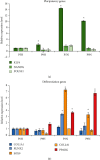Differentiation Potential of Early- and Late-Passage Adipose-Derived Mesenchymal Stem Cells Cultured under Hypoxia and Normoxia
- PMID: 33014073
- PMCID: PMC7519987
- DOI: 10.1155/2020/8898221
Differentiation Potential of Early- and Late-Passage Adipose-Derived Mesenchymal Stem Cells Cultured under Hypoxia and Normoxia
Abstract
With an increasing focus on the large-scale expansion of mesenchymal stem cells (MSCs) required for clinical applications for the treatment of joint and bone diseases such as osteoarthritis, the optimisation of conditions for in vitro MSC expansion requires careful consideration to maintain native MSC characteristics. Physiological parameters such as oxygen concentration, media constituents, and passage numbers influence the properties of MSCs and may have major impact on their therapeutic potential. Cells grown under hypoxic conditions have been widely documented in clinical use. Culturing MSCs on large scale requires bioreactor culture; however, it is challenging to maintain low oxygen and other physiological parameters over several passages in large bioreactor vessels. The necessity to scale up the production of cells in vitro under normoxia may affect important attributes of MSCs. For these reasons, our study investigated the effects of normoxic and hypoxic culture condition on early- and late-passage adipose-derived MSCs. We examined effect of each condition on the expression of key stem cell marker genes POU5F1, NANOG, and KLF4, as well as differentiation genes RUNX2, COL1A1, SOX9, COL2A1, and PPARG. We found that expression levels of stem cell marker genes and osteogenic and chondrogenic genes were higher in normoxia compared to hypoxia. Furthermore, expression of these genes reduced with passage number, with the exception of PPARG, an adipose differentiation marker, possibly due to the adipose origin of the MSCs. We confirmed by flow cytometry the presence of cell surface markers CD105, CD73, and CD90 and lack of expression of CD45, CD34, CD14, and CD19 across all conditions. Furthermore, in vitro differentiation confirmed that both early- and late-passage adipose-derived MSCs grown in hypoxia or normoxia could differentiate into chondrogenic and osteogenic cell types. Our results demonstrate that the minimal standard criteria to define MSCs as suitable for laboratory-based and preclinical studies can be maintained in early- or late-passage MSCs cultured in hypoxia or normoxia. Therefore, any of these culture conditions could be used when scaling up MSCs in bioreactors for allogeneic clinical applications or tissue engineering for the treatment of joint and bone diseases such as osteoarthritis.
Copyright © 2020 Ashley G. Zhao et al.
Conflict of interest statement
Authors have no conflicts of interest.
Figures




Similar articles
-
The effect of hypoxia on chondrogenesis of equine synovial membrane-derived and bone marrow-derived mesenchymal stem cells.BMC Vet Res. 2019 Jun 14;15(1):201. doi: 10.1186/s12917-019-1954-1. BMC Vet Res. 2019. PMID: 31200719 Free PMC article.
-
Proliferation, Characterization and Differentiation Potency of Adipose Tissue-Derived Mesenchymal Stem Cells (AT-MSCs) Cultured in Fresh Frozen and non-Fresh Frozen Plasma.Int J Mol Cell Med. 2019 Fall;8(4):283-294. doi: 10.22088/IJMCM.BUMS.8.4.283. Int J Mol Cell Med. 2019. PMID: 32587838 Free PMC article.
-
Enhancement of angiogenic effects by hypoxia-preconditioned human umbilical cord-derived mesenchymal stem cells in a mouse model of hindlimb ischemia.Cell Biol Int. 2016 Jan;40(1):27-35. doi: 10.1002/cbin.10519. Epub 2015 Aug 17. Cell Biol Int. 2016. PMID: 26222206
-
Discrepancies on the Role of Oxygen Gradient and Culture Condition on Mesenchymal Stem Cell Fate.Adv Healthc Mater. 2021 Mar;10(6):e2002058. doi: 10.1002/adhm.202002058. Epub 2021 Feb 2. Adv Healthc Mater. 2021. PMID: 33533187 Free PMC article. Review.
-
Regenerative potential of mesenchymal stromal cells in wound healing: unveiling the influence of normoxic and hypoxic environments.Front Cell Dev Biol. 2023 Oct 10;11:1245872. doi: 10.3389/fcell.2023.1245872. eCollection 2023. Front Cell Dev Biol. 2023. PMID: 37900276 Free PMC article. Review.
Cited by
-
Optimization of Mesenchymal Stromal Cell (MSC) Manufacturing Processes for a Better Therapeutic Outcome.Front Immunol. 2022 Jun 9;13:918565. doi: 10.3389/fimmu.2022.918565. eCollection 2022. Front Immunol. 2022. PMID: 35812460 Free PMC article. Review.
-
Spheroid trilineage differentiation model of primary mesenchymal stem/stromal cells under hypoxia and serum-free culture conditions.Front Bioeng Biotechnol. 2024 Jul 31;12:1444363. doi: 10.3389/fbioe.2024.1444363. eCollection 2024. Front Bioeng Biotechnol. 2024. PMID: 39144480 Free PMC article.
-
Editorial: Regulation Mechanism of Adipose-Derived Stem Cells in Differentiation and Translation.Front Physiol. 2022 Feb 25;13:852275. doi: 10.3389/fphys.2022.852275. eCollection 2022. Front Physiol. 2022. PMID: 35283758 Free PMC article. No abstract available.
-
Scale-Up of Academic Mesenchymal Stromal Cell Production.J Clin Med. 2023 Jun 30;12(13):4414. doi: 10.3390/jcm12134414. J Clin Med. 2023. PMID: 37445448 Free PMC article.
-
Regulation of base excision repair during adipogenesis and osteogenesis of bone marrow-derived mesenchymal stem cells.Sci Rep. 2023 Sep 29;13(1):16384. doi: 10.1038/s41598-023-43737-z. Sci Rep. 2023. PMID: 37773206 Free PMC article.
References
-
- Samsonraj R. M., Raghunath M., Nurcombe V., Hui J. H., van Wijnen A. J., Cool S. M. Concise review: multifaceted characterization of human mesenchymal stem cells for use in regenerative medicine. Stem Cells Translational Medicine. 2017;6(12):2173–2185. doi: 10.1002/sctm.17-0129. - DOI - PMC - PubMed
LinkOut - more resources
Full Text Sources
Research Materials
Miscellaneous

